Determining appropriate gain for high-frequency hearing losses often requires a different fitting approach from the more common downward-sloping presbyacusic configuration. Due to normal or near-normal hearing in the lower frequencies, the occlusion effect is often perceived as very annoying. This problem can be efficiently solved by using large vents or open canal fittings. Open canal fittings have grown significantly in the past few years, and there are many acoustic factors why these fittings have led to high patient benefit and satisfaction ratings (Mueller, 2006;Mueller and Ricketts, 2006). The obvious disadvantage of open canal fittings is the increased risk of feedback, which in some cases cannot be eliminated even with sophisticated feedback reduction algorithms. In many cases, only a small frequency region ("transition region") at mid frequencies (around 1000 - 2000 Hz) is available for efficient amplification. Therefore, fitting strategies that are not specifically designed for this type of hearing loss often fail to result in an acceptable "first fit" and thus, additional fine tuning adjustments may be necessary. In this paper, a new fitting approach, termed OPEN, is introduced. This fitting algorithm is designed to address the special requirements of precipitous high frequency loss, leading to a desirable initial fitting and one with low risk of acoustic feedback.
Rationale
Recent evidence from different groups of investigators suggests that in downward-sloping sensorineural hearing losses, it may not be worthwhile to focus on providing gain where high frequency audiometric thresholds exceed 60-65 dB HL. Rather, it may be better to focus on amplifying the mid or lower frequency range where gain is more readily achievable and usable. Hogan and Turner (1998) systematically studied the improvements gained in both audibility (as measured with the Articulation Index) and speech perception ability as they increased the high frequency cutoff frequency of filtered speech. They discovered that individuals with severe loss in the high frequency range did not benefit from increased audibility, and, in fact, occasionally showed a decrease in speech perception scores. Similar results have been reported by Ching, Dillon and Byrne (1998) and Vickers, Moore and Baer (2001). 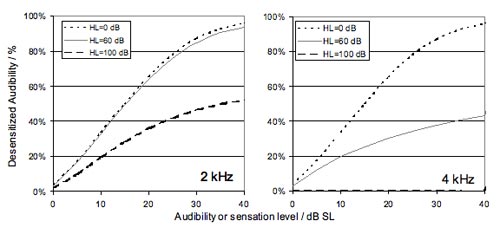
Click Here to View Larger Version of Figure 1 (PDF)
Figure 1. Hearing loss desensitization: contribution of audibility at 2 kHz and 4 kHz to speech intelligibility for various degrees of hearing loss. Adapted from Ching et al. (1998).
As shown by Figure 1, the contribution of audibility to speech intelligibility strongly depends on hearing loss and frequency. Figure 1 illustrates desensitized audibility expressed in percent (shown on the y-axis) compared to the audibility of speech expressed in dB SL (shown on the x-axis). The left panel represents 2000 Hz and the right panel represents 4000 Hz.
Whereas for normal hearing listeners speech intelligibility improves linearly with increasing audibility (up to ~30 dB SL) at mid and high frequencies, individuals with hearing losses of 60 dB HL can only use approximately 40% of audible speech for understanding speech at 4 kHz. This so-called hearing loss desensitization may be caused by dead regions (Moore, 2001) and/or auditory deprivation (Byrne & Dirks, 1996). Desensitization is already taken into account by NAL-NL1 (Byrne et al., 2001). Thus, NAL-NL1 in general is an appropriate prescription formula for high frequency hearing losses.
Feedback Considerations
The NAL-NL1 prescriptive fitting method uses information in addition to the pure tone audiogram for deriving desired fitting targets (e.g. number of compression channels, spectrum of speech, individual real ear unaided gain) (Dillon, 1999). One aspect of the fitting, however that is not taken into account by the NAL method is the maximum feedback-free gain. This is often referred to as critical gain, open loop gain (OLG) or maximum stable gain (MSG). These terms often are used as synonyms. For the purposes of this paper, the term critical gain will be used when referring to the maximum feedback-free gain in general, whereas OLG is defined as a specific technique to measure the critical gain. Since feedback is one of the most prevalent reasons for rejection of hearing aids or the use of hearing aids at a less-than-optimal gain setting, it is desirable to have a feedback-free first fit. In theory, a feedback-free fitting can be achieved by simply activating an adaptive feedback cancellation system. Such systems typically can provide approximately 15 dB additional gain (Olsen, 2005). Unfortunately, the maximum feedback-free gain varies remarkably (up to 20 dB!) in everyday life (due to jaw movements while talking, chewing, and other situational factors). For individuals at risk for feedback, it is not likely that feedback cancellation algorithms can always maintain feedback-free listening for all of these situations (Hamacher et al., 2005).
In order to guarantee maximum listening comfort in everyday situations, the OPEN fitting algorithm was developed. When attempting to prevent hearing aid feedback, it is important to consider both the stationary and the dynamic aspects of feedback. The stationary component is determined by such factors as the impedance characteristics of the ear canal, the tightness of the fit, the geometry of the outer ear, and the location of the hearing aid microphone. As discussed, the dynamic component is determined by patient-use characteristics. We believe that the prescriptive fitting formula should address the stationary component, whereas an adaptive feedback cancellation system controls the dynamic component. A commonly used method to determine the stationary component of the feedback path for a given individual is an OLG measurement (see Dillon 2001 for review).
OLG measurement
To understand the OLG technique, refer to Figure 2. This illustration shows the path of sound (solid blue line) traveling between the hearing aid microphone to the hearing aid to the receiver, and, after it is delivered into the ear canal, the path of sound (dotted line) leaking back to the hearing aid microphone where it is picked up again. It is possible, therefore, to think of sound as a closed loop (from microphone back to microphone) for all types of hearing instruments. When OLG testing is conducted, however, the hearing aid signal processing path is split between microphone and receiver. That is, the microphone signal is not forwarded to the receiver. Hence, the loop is opened, which is why it is referred to as an open loop measure.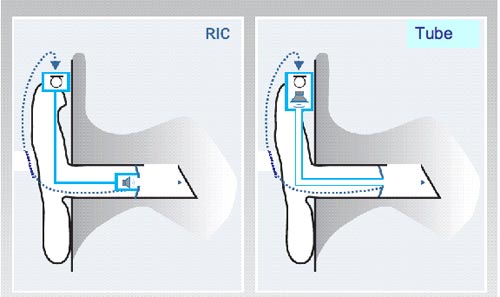
Figure 2. Stationary component of the feedback path for receiver-in-canal (RIC) and open canal with tube technology.
Now imagine what happens in the closed loop if there is no attenuation of the sound that leaves the receiver. As soon as any amount of gain is applied, the sound will be amplified by this amount in each run through the closed loop. Because of the speed of sound, this continuous looping effect quickly drives the gain to the maximum output of the hearing instrument. If there is a dominant frequency, there will be a whistle, or what has come to be known as feedback.
Given this knowledge of the physics of sound, it becomes clear that the amount of attenuation in the feedback path directly indicates how much gain can be applied without feedback. Hence, if we simply measure the attenuation between the ear canal SPL and the microphone, we know the maximum stable gain;this in fact is the OLG measurement. For example, if a tone is generated with a known output of 80 dB SPL, and the microphone picks up this tone via the feedback path and measures its level to be 10 dB SPL, then the maximum stable gain would be 70 dB at this frequency. It is important to understand that this value is unrelated to the maximum gain provided by the hearing aid used to conduct the measurement. It simply indicates the maximum stable gain that potentially could be delivered, given the ear acoustics, earmold plumbing and the microphone location of that particular fitting. Note that the feedback path essentially is the same for open fittings with tubing and receiver-in-canal technology (assuming same insertion depth and a tight tube).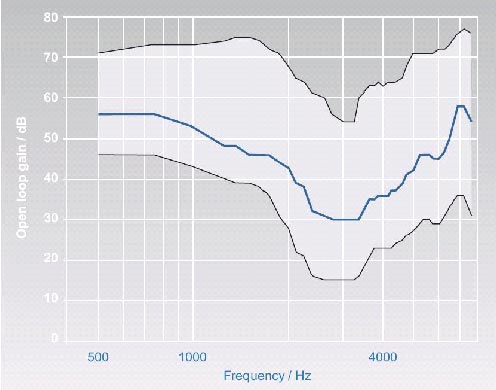
Figure 3. Range and mean of OLG measurements for 50 subjects fitted with Siemens CENTRA Active hearing instruments.
The shaded area in Figure 3 shows the range of OLG that was obtained for open canal fittings for 50 subjects. For low frequencies the range is approximately 20 dB. However, note that in the 2000-4000 Hz range, the stationary component can vary by up to 40 dB among subjects. The goal of the OPEN algorithm, therefore, is to calculate an optimal gain, which is based on the individual's OLG measurement. This algorithm then automatically maximizes speech intelligibility by taking into account high frequency desensitization and dead regions. Observe in Figure 3 that the OLG minimum (point where the least amount of gain is available) is approximately 3000 Hz. For most people with downward sloping hearing losses, this frequency region has only a small contribution to speech intelligibility;hence, if it is necessary to reduce gain at this frequency in order to maintain feedback-free listening, no significant negative consequences are expected.
Calculation of Target Gain
The procedure used for calculating optimum gain using the OPEN algorithm has been refined and validated in six different clinical studies with more than 100 subjects. Essentially, OPEN calculates the desired targets in three steps.
Step 1: Initial targets
The initial targets for OPEN are very similar to NAL-NL1;targets are calculated for several input levels. The OPEN targets have been modified slightly from NAL-NL1, using slightly reduced values. These initial OPEN targets are very similar to what has been proposed for NAL-NL2 (Dillon, 2006). To illustrate, we will use a sample patient with a mild high-frequency hearing loss. Figure 4 shows the resulting initial insertion gain targets for LTASS speech noise for input levels of 40 dB SPL, 65 dB SPL and 90 dB SPL.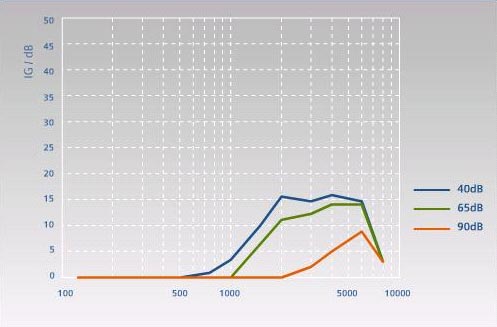
Figure 4: OPEN step 1: calculation of initial target
Step 2: Correction for critical gain
Using the OPEN algorithm, the initial target gain is then limited based on the patient's maximum stable gain (see Figure 5). Due to the large individual differences in critical gain among patients, and the importance of maximizing usable audibility, an individual OLG measurement is recommended for each patient. If no individual data are available, a statistical critical gain curve is used, which results in a feedback-free setting for the majority of fittings. 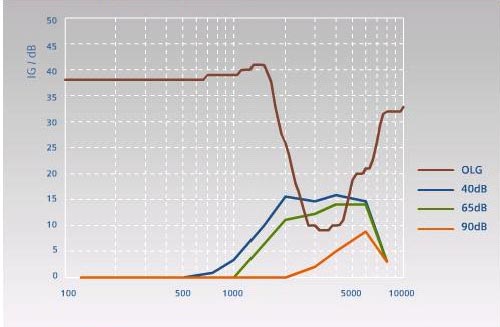
Figure 5: OPEN step 2: limitation of initial target gain to critical gain
Step3: Automatic optimization of target gain
If it is necessary to reduce gain from the initial target because of the OLG measurement, speech intelligibility is maximized to the extent possible without exceeding the overall loudness that would have been obtained using the initial target. For this optimization, OPEN uses psychoacoustic models of speech intelligibility (Ching et al., 1998) and loudness perception (Chalupper & Fastl, 2002). Both models are adapted to the individual hearing loss. In many cases, this optimization will lead to more gain at mid-frequencies. An example of this is shown in Figure 6 for a patient with a small critical gain value in the 3000 Hz range. If the modeling indicates that speech intelligibility cannot be increased, no optimization will occur and the OPEN target will be the result of the initial targets with the critical gain correction applied.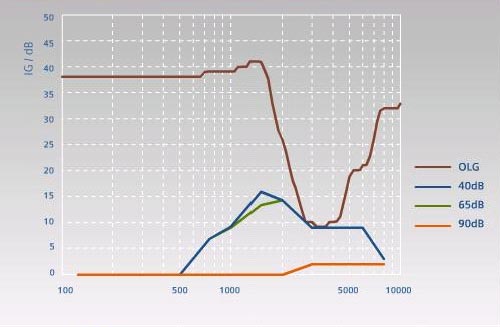
Figure 6: OPEN step 3: maximization of speech intelligibility
Clinical Studies
The new OPEN algorithm has been evaluated in several clinical studies. One such study was conducted at the University of Munich (Grosshadern). In this study, 20 adults (10 experienced users and 10 new users) with high frequency hearing loss were fitted bilaterally with Siemens ACURIS Life hearing instruments. The subjects were tested in two conditions, the OPEN condition and the NAL condition. For the OPEN condition, the hearing instruments were fitted using the OPEN algorithm without individual OLG measurement. For the NAL condition, the hearing instruments were fit using the NAL-NL1 algorithm at acclimatization level 2 (slightly reduced gain from original NAL-NL1), with individual OLG optimization (i.e. reduction of gain below critical gain) if the fitting was not stable (i.e. if feedback occurred). All adaptive signal processing was switched off for both conditions. Shown in Figure 7 are the interquartile ranges and median values of intelligibility of German monosyllables (Freiburger Einsilber) presented at 55 dB HL and 65 dB HL. The results demonstrate that speech intelligibility in quiet is not reduced for these subjects when using the OPEN algorithm as compared to NAL-NL1, even though the OPEN algorithm provided less gain in some cases. 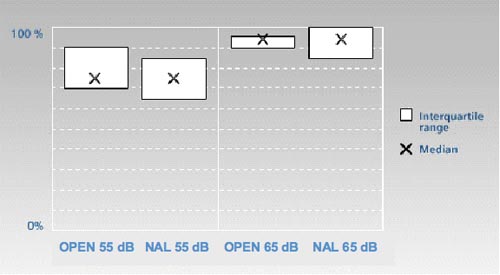
Click Here to View Larger Version of Figure 7 (PDF)
Figure 7: Speech intelligibility in quiet in the OPEN and NAL test conditions
In a separate study, the OPEN algorithm was evaluated in real-world listening conditions. In a clinical study conducted at the Hörzentrum Oldenburg, 20 subjects (10 experienced and 10 inexperienced hearing instrument users) with steeply sloping high frequency hearing loss were fitted with Siemens Acuris Life hearing instruments. The hearing aids were fitted according to OPEN targets without individual OLG measurements. All adaptive signal processing was activated. In the first part of the study, subjects listened to several different types of sound examples and were asked whether this fitting was acceptable for routine use for at least six hours per day. With regard to this question, no subject required fine tuning. The participants then used the hearing aids in their everyday listening conditions for at least two weeks. After the trial period, the participants rated the listening experience on three factors: annoyance from feedback, sound quality and speech intelligibility. For all ratings, an 11-point scale (0 to 10) was used. For "annoyance from feedback" the scale ranged from "very often" to "never";for sound quality, the scale ranged from "unnatural" to "natural" and for speech intelligibility "I understand nothing" and "I understand everything" were used as anchors.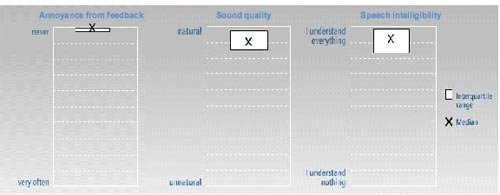
Click Here to View Larger Version of Figure 8 (PDF)
Figure 8: Subjective ratings in real-world listening conditions: Annoyance from feedback, sound quality and speech intelligibility
Figure 8 shows the results of the participants' ratings for the three different factors during the real-world listening portion of the experiment. Observe, in all cases, that highly positive findings were obtained. First, as may be predicted from use of the critical gain model and given the advanced feedback reduction algorithm of ACURIS Life, feedback was rarely a problem. Sound quality was rated very high, suggesting that the open fitting had provided the desired natural sound. With regard to ratings of speech intelligibility, recall that this protocol had fitted the subjects without individual OLG measurement, therefore most of the participants were using less gain in the high frequencies than would be recommended in an initial NAL-NL1 fitting. We were therefore very encouraged to see that speech intelligibility ratings were rated so high. The results of this study indicate that the OPEN algorithm prescribes a target gain for open canal fittings which, in real world listening situations, is virtually feedback-free and simultaneously results in user ratings of high sound quality and good speech intelligibility.
Conclusions
Psychoacoustic models for speech intelligibility and loudness can be used successfully for deriving a prescriptive fitting rule (i.e., the OPEN algorithm) dedicated specifically to high frequency hearing losses. Since open canal fittings are often used for patients with this hearing loss configuration, the risk of feedback is increased significantly. In order to assure feedback-free listening in most real life conditions, OPEN redistributes gain across frequencies if it is necessary and beneficial. This is achieved by an optimization procedure that maximizes speech intelligibility without exceeding maximum stable gain and comfortable loudness. As shown in clinical studies, OPEN almost completely eliminates annoyance of feedback, has the same speech intelligibility in quiet as NAL-NL1 and results in a high sound quality and subjective speech intelligibility. The OPEN prescriptive procedure, therefore, is a good alternative to traditional NAL-NL1 targets when critical gain testing indicates the need for reduced high frequency gain, or whenever real-world feedback problems are noted or anticipated.
References
Byrne D., Dillon H., Ching T. (2001). NAL-NL1 procedure for fitting non-linear hearing aids: Characteristics and comparisons with other procedures. JAAA 12(1), 37-51.
Byrne, D., Dirks, D. (1996). Effects of acclimatization and deprivation on non-speech auditory abilities. Ear Hear 17(3 Suppl): 29S-37S.
Chalupper, J., Fastl, H. (2002). Dynamic loudness model (DLM) for normal and hearing-impaired listeners. Acustica/acta acustica 88: 378-386.
Ching, T., Dillon, H. and Byrne, D. (1998). Speech recognition of hearing impaired listeners: Predictions from audibility and the limited role of high frequency amplification. J Acoust Soc Am 103, 1128-1140.
Dillon, H. (1999). NAL-NL1: A new prescriptive fitting procedure for non-linear hearing aids. Hearing Journal 52(4): 10-16.
Dillon, H. (2001). Hearing Aids. New York: Thieme.
Dillon, H. (2006). What's new from NAL in hearing aid prescriptions? Hearing Journal 59 (10): 10-16.
Hamacher V., Chalupper J., Eggers, J., Fischer, E., Kornagel, U., Puder, H., Rass, U., (2005). Signal Processing in High-End Hearing Aids: State of the Art, Challenges and Future Trends. EURASIP Journal on Applied Signal Processing 18, 1-15.
Hogan, C.A., and Turner, C.W. (1998). High frequency audibility: Benefits for listeners with high frequency hearing loss. J Acoust Soc Am 104, 432-441.
Moore, B. C. J. (2001). Dead regions in the cochlea: Diagnosis, perceptual consequences, and implications for the fitting of hearing aids. Trends Amplif 2001;5(1):1-34.
Mueller, H. G. (2006). Open is in. Hearing Journal 59 (11): 11-14.
Mueller, H. G., Ricketts, T. (2006). Open-canal fittings: Ten take-home tips.
Olsen, S. O. (2005, August - September).
Vickers, D. A., Moore, B. C. J., Baer, T. (2001). Effects of low-pass filtering on the intelligibility of speech in quiet for people with and without dead regions at high frequencies. J Acoust Soc Am 110 (2), 1164-1175.
Maximizing Speech Intelligibility for Open Canal Fittings
September 15, 2008
This article is sponsored by Signia.
Related Courses
1
https://www.audiologyonline.com/audiology-ceus/course/auditory-wellness-what-clinicians-need-36608
Auditory Wellness: What Clinicians Need to Know
As most hearing care professionals know, the functional capabilities of individuals with hearing loss are defined by more than the audiogram. Many of these functional capabilities fall under the rubric, auditory wellness. This podcast will be a discussion between Brian Taylor of Signia and his guest, Barbara Weinstein, professor of audiology at City University of New York. They will outline the concept of auditory wellness, how it can be measured clinically and how properly fitted hearing aids have the potential to improve auditory wellness.
auditory
129
USD
Subscription
Unlimited COURSE Access for $129/year
OnlineOnly
AudiologyOnline
www.audiologyonline.com
Auditory Wellness: What Clinicians Need to Know
As most hearing care professionals know, the functional capabilities of individuals with hearing loss are defined by more than the audiogram. Many of these functional capabilities fall under the rubric, auditory wellness. This podcast will be a discussion between Brian Taylor of Signia and his guest, Barbara Weinstein, professor of audiology at City University of New York. They will outline the concept of auditory wellness, how it can be measured clinically and how properly fitted hearing aids have the potential to improve auditory wellness.
36608
Online
PT30M
Auditory Wellness: What Clinicians Need to Know
Presented by Brian Taylor, AuD, Barbara Weinstein, PhD
Course: #36608Level: Intermediate0.5 Hours
AAA/0.05 Intermediate; ACAud inc HAASA/0.5; AHIP/0.5; ASHA/0.05 Intermediate, Professional; BAA/0.5; CAA/0.5; Calif. SLPAB/0.5; IACET/0.1; IHS/0.5; Kansas, LTS-S0035/0.5; NZAS/1.0; SAC/0.5
As most hearing care professionals know, the functional capabilities of individuals with hearing loss are defined by more than the audiogram. Many of these functional capabilities fall under the rubric, auditory wellness. This podcast will be a discussion between Brian Taylor of Signia and his guest, Barbara Weinstein, professor of audiology at City University of New York. They will outline the concept of auditory wellness, how it can be measured clinically and how properly fitted hearing aids have the potential to improve auditory wellness.
2
https://www.audiologyonline.com/audiology-ceus/course/understanding-patient-empowerment-along-hearing-37890
Understanding Patient Empowerment Along the Hearing Health Journey
Most clinicians recognize the importance of empowerment in the patient journey, but do they know what it really means for a patient to feel empowered? Find out in this engaging and informative podcast with WSA research scientist, Sarah Gotowiec, PhD, who reviews the five dimensions of patient empowerment and how clinicians can apply her research to empower patients more effectively throughout the patient journey. This recent open access article is the focus of her discussion: https://www.tandfonline.com/doi/full/10.1080/14992027.2021.1915509
auditory
129
USD
Subscription
Unlimited COURSE Access for $129/year
OnlineOnly
AudiologyOnline
www.audiologyonline.com
Understanding Patient Empowerment Along the Hearing Health Journey
Most clinicians recognize the importance of empowerment in the patient journey, but do they know what it really means for a patient to feel empowered? Find out in this engaging and informative podcast with WSA research scientist, Sarah Gotowiec, PhD, who reviews the five dimensions of patient empowerment and how clinicians can apply her research to empower patients more effectively throughout the patient journey. This recent open access article is the focus of her discussion: https://www.tandfonline.com/doi/full/10.1080/14992027.2021.1915509
37890
Online
PT30M
Understanding Patient Empowerment Along the Hearing Health Journey
Presented by Brian Taylor, AuD, Sarah Gotowiec, PhD
Course: #37890Level: Intermediate0.5 Hours
AAA/0.05 Intermediate; ACAud inc HAASA/0.5; AHIP/0.5; ASHA/0.05 Intermediate, Professional; BAA/0.5; CAA/0.5; Calif. SLPAB/0.5; IACET/0.1; IHS/0.5; Kansas, LTS-S0035/0.5; NZAS/1.0; SAC/0.5
Most clinicians recognize the importance of empowerment in the patient journey, but do they know what it really means for a patient to feel empowered? Find out in this engaging and informative podcast with WSA research scientist, Sarah Gotowiec, PhD, who reviews the five dimensions of patient empowerment and how clinicians can apply her research to empower patients more effectively throughout the patient journey. This recent open access article is the focus of her discussion: https://www.tandfonline.com/doi/full/10.1080/14992027.2021.1915509
3
https://www.audiologyonline.com/audiology-ceus/course/wireless-technology-in-hearing-aids-40196
Wireless Technology in Hearing Aids
The use of wireless technologies in hearing aids as increased over the years. This course will examine types of wireless technology commonly used in hearing aids.
auditory, textual, visual
129
USD
Subscription
Unlimited COURSE Access for $129/year
OnlineOnly
AudiologyOnline
www.audiologyonline.com
Wireless Technology in Hearing Aids
The use of wireless technologies in hearing aids as increased over the years. This course will examine types of wireless technology commonly used in hearing aids.
40196
Online
PT30M
Wireless Technology in Hearing Aids
Presented by Eric Branda, PhD, AuD
Course: #40196Level: Intermediate0.5 Hours
AAA/0.05 Intermediate; ACAud inc HAASA/0.5; AHIP/0.5; ASHA/0.05 Intermediate, Professional; BAA/0.5; CAA/0.5; IACET/0.1; IHS/0.5; Kansas, LTS-S0035/0.5; NZAS/1.0; SAC/0.5; TX TDLR, #142/0.5 Manufacturer, X
The use of wireless technologies in hearing aids as increased over the years. This course will examine types of wireless technology commonly used in hearing aids.
4
https://www.audiologyonline.com/audiology-ceus/course/breaking-barriers-empowering-social-connections-40197
Breaking Barriers: Empowering Social Connections in Older Adults with Hearing Loss
Hearing loss of gradual onset in older adults affects social connections. Breaking away from the impairment-driven model of hearing healthcare and focusing on a wellness-driven model, this course describes how hearing loss contributes to social disconnection, and how various empowerment strategies can be used clinically to improve the social and emotional well-being of these individuals.
auditory, textual, visual
129
USD
Subscription
Unlimited COURSE Access for $129/year
OnlineOnly
AudiologyOnline
www.audiologyonline.com
Breaking Barriers: Empowering Social Connections in Older Adults with Hearing Loss
Hearing loss of gradual onset in older adults affects social connections. Breaking away from the impairment-driven model of hearing healthcare and focusing on a wellness-driven model, this course describes how hearing loss contributes to social disconnection, and how various empowerment strategies can be used clinically to improve the social and emotional well-being of these individuals.
40197
Online
PT60M
Breaking Barriers: Empowering Social Connections in Older Adults with Hearing Loss
Presented by Brian Taylor, AuD
Course: #40197Level: Intermediate1 Hour
AAA/0.1 Intermediate; ACAud inc HAASA/1.0; ASHA/0.1 Intermediate, Professional; BAA/1.0; CAA/1.0; Calif. SLPAB/1.0; IACET/0.1; IHS/1.0; Kansas, LTS-S0035/1.0; NZAS/1.0; SAC/1.0; TX TDLR, #142/1.0 Manufacturer, X
Hearing loss of gradual onset in older adults affects social connections. Breaking away from the impairment-driven model of hearing healthcare and focusing on a wellness-driven model, this course describes how hearing loss contributes to social disconnection, and how various empowerment strategies can be used clinically to improve the social and emotional well-being of these individuals.
5
https://www.audiologyonline.com/audiology-ceus/course/signia-expert-hearingaid-fitting-nuggets-37894
Signia Expert Series: Hearing Aid Fitting Nuggets Mined From Recent Research
Each year, over 300 articles are published in professional journals related to the function and fitting of hearing aids. Some are rather esoteric, but others have data that provide unique fitting tips that can be applied on Monday morning! We'll review the key findings of some of this emerging research that hopefully will be useful to you and beneficial for your patients.
auditory, textual, visual
129
USD
Subscription
Unlimited COURSE Access for $129/year
OnlineOnly
AudiologyOnline
www.audiologyonline.com
Signia Expert Series: Hearing Aid Fitting Nuggets Mined From Recent Research
Each year, over 300 articles are published in professional journals related to the function and fitting of hearing aids. Some are rather esoteric, but others have data that provide unique fitting tips that can be applied on Monday morning! We'll review the key findings of some of this emerging research that hopefully will be useful to you and beneficial for your patients.
37894
Online
PT60M
Signia Expert Series: Hearing Aid Fitting Nuggets Mined From Recent Research
Presented by H. Gustav Mueller, PhD
Course: #37894Level: Intermediate1 Hour
AAA/0.1 Intermediate; ACAud inc HAASA/1.0; AHIP/1.0; ASHA/0.1 Intermediate, Professional; BAA/1.0; CAA/1.0; Calif. SLPAB/1.0; IACET/0.1; IHS/1.0; Kansas, LTS-S0035/1.0; NZAS/1.0; SAC/1.0
Each year, over 300 articles are published in professional journals related to the function and fitting of hearing aids. Some are rather esoteric, but others have data that provide unique fitting tips that can be applied on Monday morning! We'll review the key findings of some of this emerging research that hopefully will be useful to you and beneficial for your patients.

